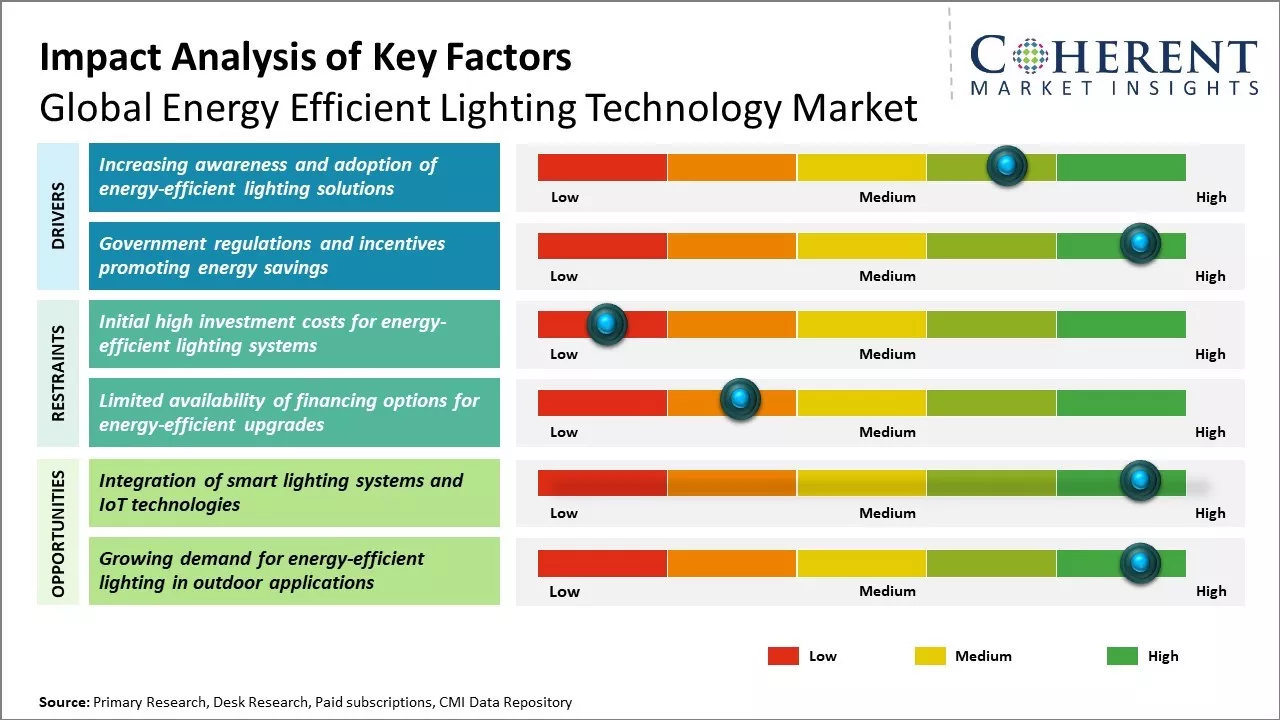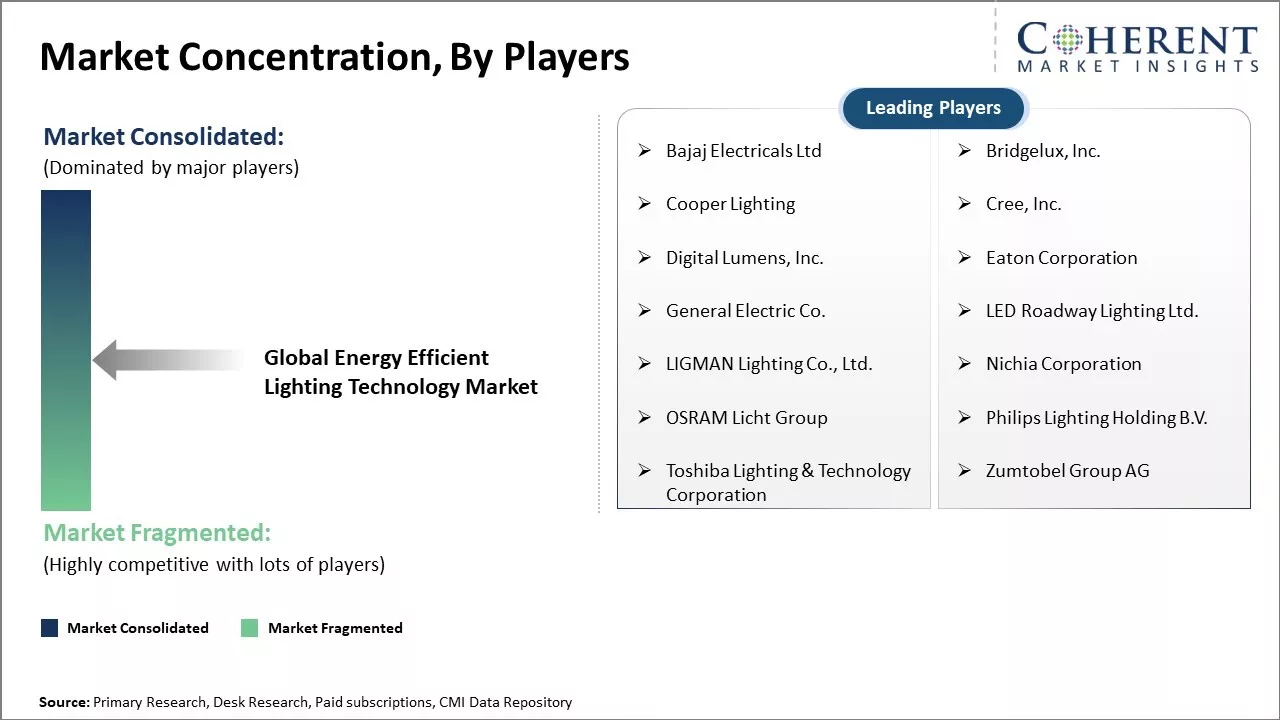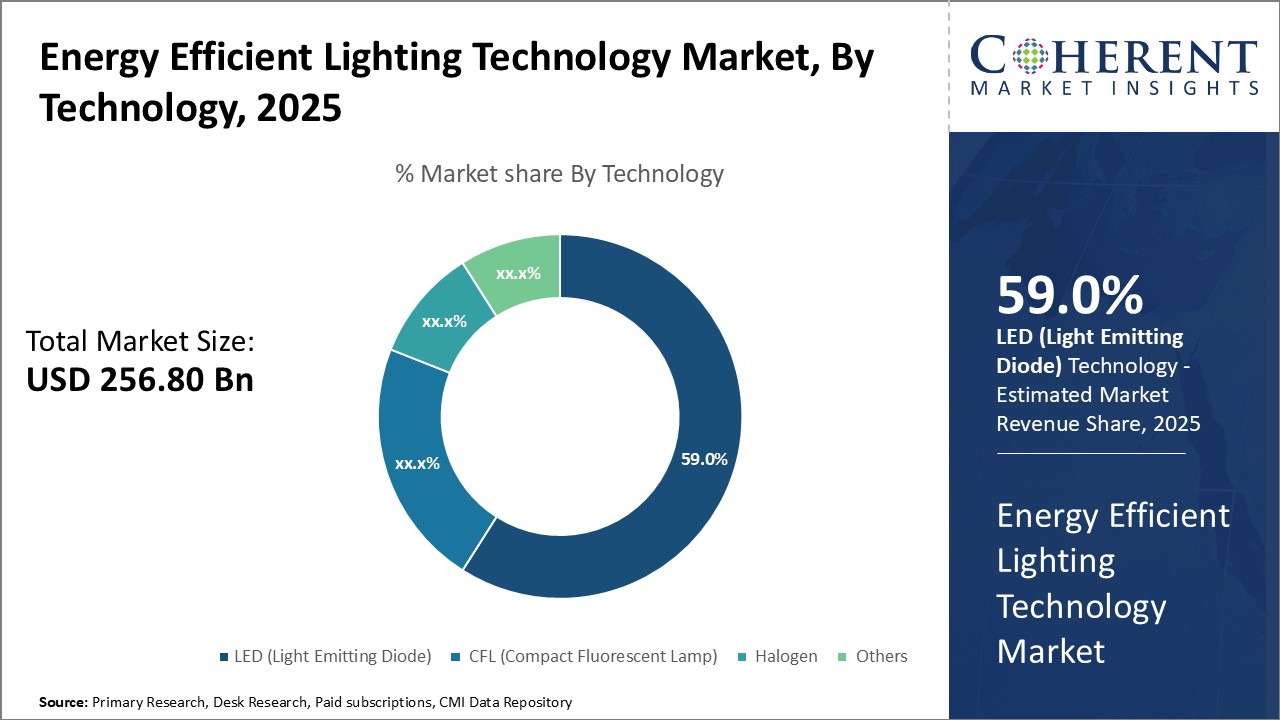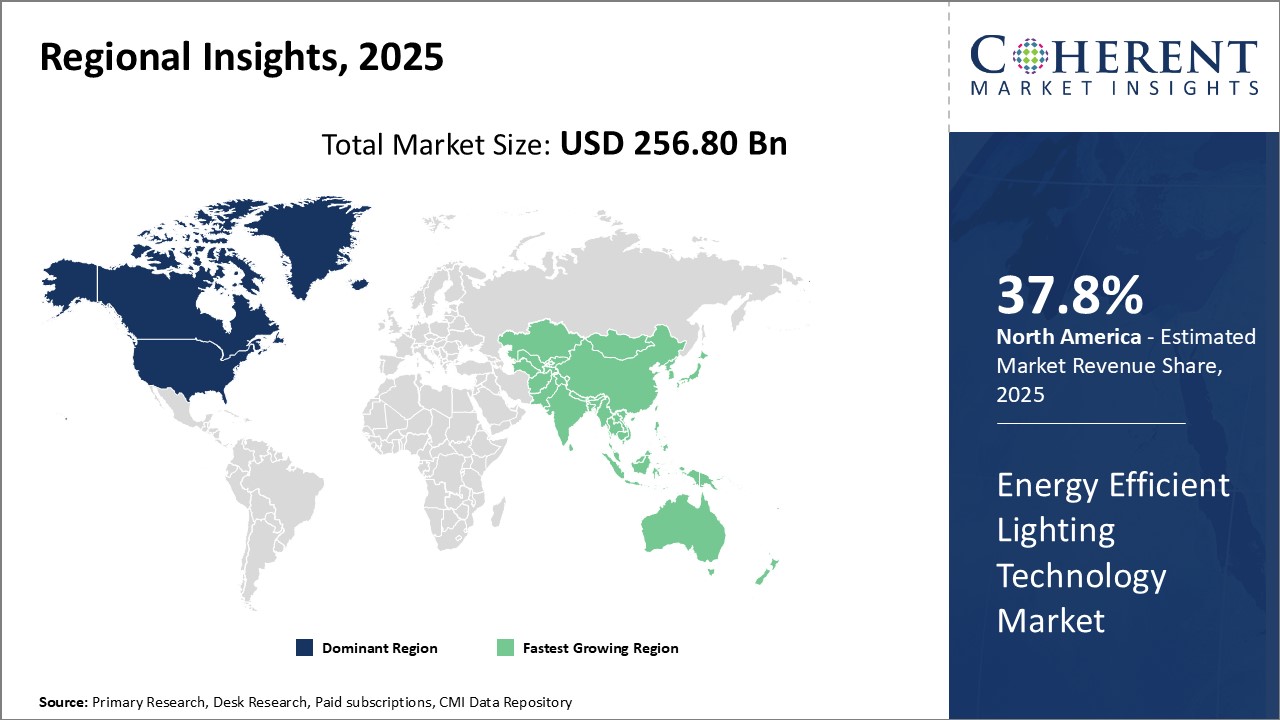Energy Efficient Lighting Technology Market Size and Trends
Global energy efficient lighting technology market is estimated to be valued at USD 256.80 Bn in 2025 and is expected to reach USD 443.27 Bn by 2032, exhibiting a compound annual growth rate (CAGR) of 8.1% from 2025 to 2032.

Discover market dynamics shaping the industry: Download Free Sample
Energy efficient lighting helps reduce energy costs significantly and enhances productivity. Governments across the globe supports the adoption of such technologies through policies and incentives to lower carbon emissions. The market is witnessing significant growth due to rising environmental awareness and stringent regulations regarding energy consumption globally. Many countries have formulated policies that mandate adoption of energy efficient lighting solutions in public infrastructure and buildings. Additionally, factors such as growing need to reduce carbon footprint, advancement in LED technology and its cost competitiveness compared to traditional lighting are fueling adoption of energy efficient lighting systems among industrial and commercial users.
Market Driver - Increasing awareness and adoption of energy efficient lighting solutions
With rising costs of electricity and focus on reducing carbon footprint, people and organizations across the globe have become highly conscious about saving energy. Lighting solutions account for a significant portion of total energy usage. Conventional lighting technologies like incandescent bulbs are very inefficient and convert more than 90% of energy input into heat. In comparison, modern energy efficient alternatives can reduce lighting energy consumption by over 75%. Increased internet connectivity enables wider dissemination of information related to benefits of transitioning to LED and other low-power lighting options. Many developing supportive policies and programs promote greater switching to efficient lighting. Environmental groups and worldwide movement for sustainability have also emphasized the need for more widespread use of efficient lighting.
Individuals and commercial establishments can meaningfully reduce their monthly electricity bills by retrofitting to LED bulbs, tubes or fixtures. Lifetime cost of ownership is also much lower as compared to traditional incandescent or CFL options which require frequent replacements. Along with direct savings, efficient lighting enhances productivity for offices and industries by providing superior illumination for visual tasks. Improved quality and intensity of light results in fewer sick leaves and accidents. Many organizations have reported increase in sales and efficiency of operations after transitioning to LEDs. Growing awareness about these tangible benefits through social media and advertising can lead to higher rates of voluntary adoption for Energy efficient lighting.
Public demonstrations of innovative lighting technologies at expos and conferences have captivated audience interest. Many urban local bodies have initiated awareness drives and special programs, making affordable financing available for efficient lighting upgrades. Residential building developers extensively promote energy saving aspect of properties to attract environment conscious homeowners and tenants. Steadily declining prices of LEDs and solar lights have removed previous barriers of high upfront capital. Growing inclination towards sustainability, availability of reliable performance data and financial appeals have boosted widespread embrace of energy efficient lighting options.
Market Concentration and Competitive Landscape

Get actionable strategies to beat competition: Download Free Sample
Government regulations and incentives promoting energy savings
Parallel measures include phasing out incandescent bulbs and forcing upgrading of street lights, traffic signals and public infrastructure to LEDs or other low-power technologies. Strict timelines have been provided for full transition. Non-compliant items face import/export restrictions or high taxation. Such mandates drives lighting industry towards globally recognized efficient designs and driving prices down through economies of scale.
Financial incentives widely used by governments include rebates on efficient lighting, lower taxes on LEDs and exemptions on custom duties. Many administer rebate programs, providing direct price discounts for high-performance bulbs, tubes or luminaries. Energy efficient mortgages at lower interest rates have encouraged home efficiency upgrades including efficient lighting installations. Grants are allocated to cities and organizations retrofitting streets, public spaces and infrastructure. Carbon credits or tradable renewable energy certificates have promoted large scale commercial and industrial lighting energy makeovers.
Strict mandates combined with attractive financial carrots have proved highly impactful in accelerating adoption. Compliance is closely monitored and defaulters penalized, thus, providing regulations added strength. Most incentives are temporary but sufficient to firmly establish efficient lighting in mainstream usage. These promote local industries, jobs and sustainable development priorities. Collective efforts of public and private stakeholders have enabled many nations transition significantly towards efficiently lit future.
Key Takeaways from Analyst:
The global energy efficient lighting technology market is set for significant growth over the next decade. Stringent government regulations regarding energy consumption and carbon emissions will drive the increased adoption of LED and other efficient lighting solutions across both commercial and residential applications. Furthermore, heightened consumer awareness about the cost savings associated with efficient lighting, combined with decreasing prices of LED bulbs, is expected to further boost market revenues.
The North America region, led by countries such as U.S., Canada will continue to dominate the market due to extensive building construction programs and smart city initiatives. While Asia Pacific is the fastest growing region for energy efficient lighting technology market.
Although higher initial costs for installing efficient lighting systems may pose challenges to market growth, the declining prices of LEDs over time are likely to mitigate these concerns. Advancements in lighting control systems and the integration of lighting with IoT technology are expected to create new revenue streams for companies. Additionally, the rise of contract manufacturing may influence companies that produce their own lighting products.
Overall, the global energy efficient lighting technology market is poised for steady growth, driven by technological improvements and initiatives aimed at reducing energy usage worldwide. Emerging trends, such as a focus on connected lighting solutions and new applications like horticulture, are areas that companies should closely monitor.
Market Challenge - Initial high investment costs for energy efficient lighting systems
Energy efficient lighting systems such as LED lights require higher initial capital investments as compared to traditional incandescent or CFL bulbs. While LED lights save considerable energy costs due to their longer lifespan and lower power consumption, their upfront costs tend to be significantly higher. This high initial price point acts as a deterrent for many commercial and residential consumers and hampers wider adoption of such technologies. LED light fittings can be twice as costly as ordinary fluorescent tube lights, whereas CFL lamps are only marginally cheaper than incandescent bulbs. Furthermore, complete replacement of conventional lighting with new energy efficient systems in large office buildings or factories involves substantial expenditure.
Opportunity: Integration of smart lighting systems and IoT technologies
The integration of smart lighting systems and internet of things (IoT) technologies provides huge opportunities for the energy efficient lighting technology market. Smart lights that can be controlled remotely through mobile apps or voice commands are gaining popularity. These allow adjustment of brightness levels based on occupancy and daylight availability. IoT-enabled lights send usage data to cloud platforms where it can be analyzed for maintenance needs and energy management. This leads to further optimization of lighting infrastructure. Manufacturers are increasingly offering 'lighting as a service' through Software as a Service (SaaS) models. This helps overcome the initial cost hurdle and allows facilities to pay as per actual light usage instead of large upfront capital expenditure.

Discover high revenue pocket segments and roadmap to it: Download Free Sample
Insights By Technology - LED (Light Emitting Diode) Segment Leads the Market Due to Technological Superiority
In terms of technology, LED (light emitting diode) segment is estimated to contribute the highest market share of 59.0% in 2025, owing to its inherent technological advantages over other available options. LED lights offer unmatched energy efficiency, with some models using up to 90% less energy than traditional incandescent bulbs. These also emit very little heat and last significantly longer - up to 25 times longer than equivalent halogen bulbs. This drastically lowers long-term maintenance and replacement costs for both residential and commercial applications. LED lights are extremely durable and withstand vibrations, impacts and temperature variations better than other technologies. Their compact size allows for innovative form factors and stylish fixture designs. With continual technological advancements, cost of LED lights is steadily decreasing while the light output is increasing. LED lights contain no toxic materials like mercury, thus, reduces environmental impact. These performance and economic benefits have established LED lights as the technology of choice. For instance, In June 2021, Syska LED, a prominent player in the lighting solutions industry, launched its new T5 LED Batten brand in India, featuring advanced 440V over-voltage protection. These innovative LED lights are designed to enhance lighting quality while ensuring safety and reliability.
Insights By Application - Residential Segment Fuels Market Growth Due to Unique Advantages Offered by LED Lights for Household Use
In terms of application, residential segment is estimated to contribute the highest market share of 36.1% in 2025, owing to unique advantages LED lights provide for household usage. This makes them ideal for frequently switched lights in areas like staircases, hallways and outdoor spaces. Their long lifespan reduces the hassle of frequent bulb replacements. LED lights also enable creative layouts and accent lighting designs easily with minimal wiring. Variety of form factors like A-lamps, globes and reflector bulbs make LED replacements compatible with most conventional fixtures. As energy prices increases, household savings from LED lighting have become a major incentive for residential consumers seeking cost-effective solutions. These benefits of convenience, style and efficiency have boosted adoption of LED technology for residential indoor and outdoor illumination needs.
Insights By End User - Households Segment Dominates Due to Value Offered to Commercial Users
In terms of end user, households’ segment is estimated to contribute the highest market share of 44.7% in 2025, owing to the distinctive value proposition LED lighting delivers to commercial establishments. The energy cost reductions achieved through LED installation provide a short payback period and high return on investment for business owners. Long-lasting luminaires require less frequent lamp replacements and maintenance, reducing overhead costs. Sophisticated ambient and task lighting solutions from LED improve workforce productivity in office and retail environments. Moreover, ability to centrally control and monitor lighting networks enables gathering valuable energy usage data. LED luminaires also withstand round-the-clock usage better without loss of brightness. The even light distribution and customizable spectrum options suit diverse visual needs. As companies emphasize energy efficiency and sustainability goals, LED lights substantiate green credentials.
Regional Insights

Need a Different Region or Segment? Download Free Sample
North America dominates the global energy efficient lighting technology market with an estimated market share of 37.8% share in 2025. The presence of major lighting brands and OEMs such as Philips Lighting, GE Lighting, and OSRAM in the U.S. and Canada has cemented North America's leadership position. There has been huge demand for innovative and energy efficient lighting solutions across both commercial and residential sectors due to need to reduce energy consumption and costs. The governments in the U.S. and Canada have also promoted adoption of LED and other efficient lighting through initiatives such as ENERGY STAR program which requires all lighting products to meet minimum efficiency standards. This has encouraged local manufacturers to invest heavily in R&D to develop new and improved lighting technologies.
Asia Pacific region is emerging as the fastest growing market for energy efficient lighting technologies. Countries such as China, Japan and India offer immense growth opportunities, owing to their large populations and increasing construction activities. Rapid urbanization and improving economic conditions have increased disposable incomes, and this boosts demand for innovative and advanced lighting solutions. The presence of strong electronics and components manufacturing base in the region allows low-cost production of LED and other lighting products. This has made Asia Pacific an attractive sourcing destination for lighting brands globally. Growing exports from the region have made it a lighting hub. However, price wars among the local manufacturers and availability of low-cost conventional lighting can challenge widespread adoption of most efficient technologies in some parts of Asia Pacific.
Policy pushes and initiatives towards green construction in developed markets along with robust component manufacturing can boost North America's consistent leadership. Meanwhile, economic growth, urbanization and availability of low-cost production boosts Asia Pacific’s emergence as the fastest expanding regional market for energy efficient lighting technologies globally.
Market Report Scope
Energy Efficient Lighting Technology Market Report Coverage
| Report Coverage | Details | ||
|---|---|---|---|
| Base Year: | 2024 | Market Size in 2025: | USD 256.80 Bn |
| Historical Data for: | 2020 To 2024 | Forecast Period: | 2025 To 2032 |
| Forecast Period 2025 to 2032 CAGR: | 8.1% | 2032 Value Projection: | USD 443.27 Bn |
| Geographies covered: |
|
||
| Segments covered: |
|
||
| Companies covered: |
Bajaj Electricals Ltd, Bridgelux, Inc., Cooper Lighting, Cree, Inc., Digital Lumens, Inc., Eaton Corporation, General Electric Co., LED Roadway Lighting Ltd., LIGMAN Lighting Co., Ltd., Nichia Corporation, OSRAM Licht Group, Philips Lighting Holding B.V., Toshiba Lighting & Technology Corporation, and Zumtobel Group AG |
||
| Growth Drivers: |
|
||
| Restraints & Challenges: |
|
||
Uncover macros and micros vetted on 75+ parameters: Get instant access to report
Energy Efficient Lighting Technology Industry News
- In August 2023, Philips, a leading global provider of innovative lighting solutions, announced the launch of its latest smart LED lighting products, which feature advanced connectivity and energy-saving capabilities. These products can be controlled through a mobile app, enabling users to customize settings for optimal efficiency.
- In July 2023, ams OSRAM, a leading global provider of innovative optoelectronic solutions, unveiled a new series of organic LED (OLED) panels designed for architectural and automotive lighting applications. These advanced panels offer improved energy efficiency and design flexibility, catering to the aesthetic demands of modern lighting solutions.
- In May 2023, Cree Lighting, a leading innovator in LED lighting solutions, announced the release of its next-generation LED street lights designed to maximize energy efficiency and extend lifespan. These advanced lights contribute to smart city initiatives by providing reliable and sustainable illumination.
- In April 2023, Sylvania, a leading provider of innovative lighting solutions, introduced a new range of eco-friendly LED bulbs made from recyclable materials. These products are designed to minimize environmental impact while delivering long-lasting lighting solutions for both residential and commercial applications.
*Definition: Global energy efficient lighting technology Market consists of companies that develop and manufacture energy efficient lighting technologies and products that use less electricity to produce the same amount of visible light compared to traditional incandescent light bulbs. This includes LED lights, CFL lights, fluorescent tube lights and other lighting technologies that reduce energy consumption and help lower carbon emissions globally.
Market Segmentation
- Technology Insights (Revenue, USD Bn, 2020 - 2032)
-
- LED (Light Emitting Diode)
- CFL (Compact Fluorescent Lamp)
- Halogen
- Others
- Application Insights (Revenue, USD Bn, 2020 - 2032)
-
- Residential
- Commercial
- Industrial
- Outdoor
- Others
- End User Insights (Revenue, USD Bn, 2020 - 2032)
-
- Households
- Retail
- Hospitality
- Healthcare
- Education
- Others
- Regional Insights (Revenue, USD Bn, 2020 - 2032)
- North America
- U.S.
- Canada
- Latin America
- Brazil
- Argentina
- Mexico
- Rest of Latin America
- Europe
- Germany
- U.K.
- Spain
- France
- Italy
- Russia
- Rest of Europe
- Asia Pacific
- China
- India
- Japan
- Australia
- South Korea
- ASEAN
- Rest of Asia Pacific
- Middle East
- GCC Countries
- Israel
- Rest of Middle East
- Africa
- South Africa
- North Africa
- Central Africa
- North America
- Key Players Insights
- Bajaj Electricals Ltd
- Bridgelux, Inc.
- Cooper Lighting
- Cree, Inc.
- Digital Lumens, Inc.
- Eaton Corporation
- General Electric Co.
- LED Roadway Lighting Ltd.
- LIGMAN Lighting Co., Ltd.
- Nichia Corporation
- OSRAM Licht Group
- Philips Lighting Holding B.V.
- Toshiba Lighting & Technology Corporation
- Zumtobel Group AG
Share
Share
About Author
Yash Doshi is a Senior Management Consultant. He has 12+ years of experience in conducting research and handling consulting projects across verticals in APAC, EMEA, and the Americas.
He brings strong acumen in helping chemical companies navigate complex challenges and identify growth opportunities. He has deep expertise across the chemicals value chain, including commodity, specialty and fine chemicals, plastics and polymers, and petrochemicals. Yash is a sought-after speaker at industry conferences and contributes to various publications on topics related commodity, specialty and fine chemicals, plastics and polymers, and petrochemicals.
Missing comfort of reading report in your local language? Find your preferred language :
Transform your Strategy with Exclusive Trending Reports :
Frequently Asked Questions
EXISTING CLIENTELE
Joining thousands of companies around the world committed to making the Excellent Business Solutions.
View All Our Clients
